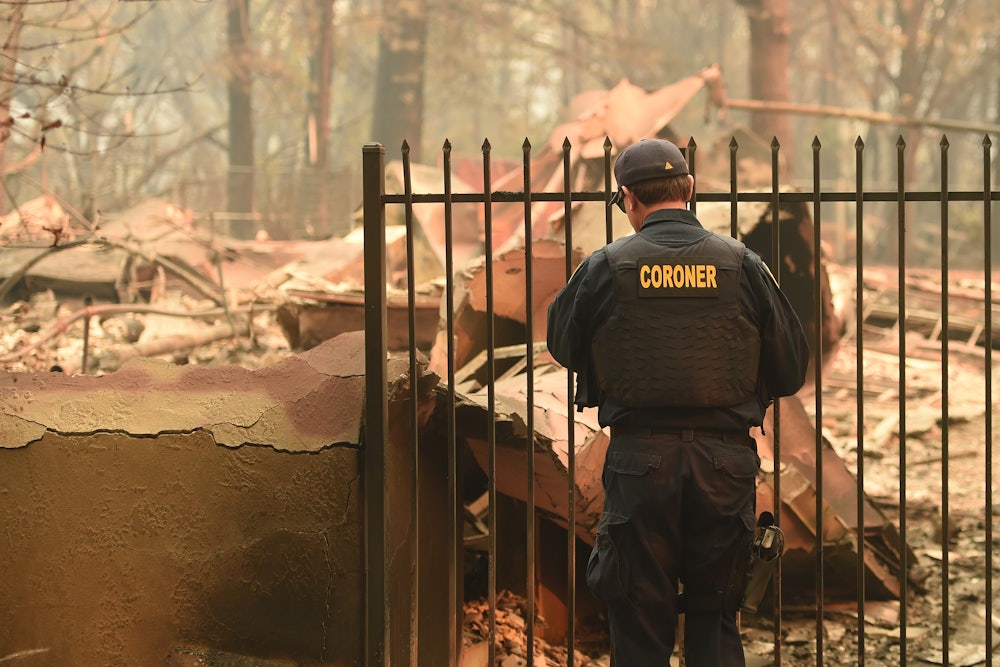Rescue teams are still searching through burned rubble for bodies after a massive wildfire devastated Butte County, California, last week. About 100 people are still missing. But already the Camp Fire, which continues to burn, has gone down in history as the deadliest blaze ever recorded in the state, during one of the deadliest fire seasons in several decades.
On Wednesday, Butte County officials said they had discovered the remains of six more people, bringing the overall death toll from the fire to 48. These are not the only wildfire fatalities in California of late. South of Butte County, the ongoing Woolsey Fire has so far been blamed for two deaths. One firefighter was killed in the Mendocino Complex fire in August, and two firefighters died battling July’s Ferguson Fire. That same month, three firefighters and five civilians died in the Carr Fire.
In all, California’s 2018 wildfire season so far has taken 61 lives—a staggering number compared to the last 10 years, according to data from California’s state firefighting agency.
To understand how severe this problem has become, it’s useful to compare California’s fatal wildfires to other causes of death. A mass shooting in a bar in Thousand Oaks last week left 13 dead—the third mass shooting in the state this year, according to a Mother Jones database. But more people have died in wildfires than in mass shootings in California this year, continuing a trend that started in 2016. (Thousand Oaks was also hit by the Woolsey Fire.)
For the first time in years, the number of people killed by wildfires in California is about the same as the number of people who got hit by a train and died, according to Bureau of Transportation data.
If wildfire deaths in California continue at this rate, the number will soon be comparable to the number of people who die in the United States due to terrorism, the Global Terrorism Database indicates. (That database doesn’t include numbers from 2018, but a list put together by physicist Robert Johnson puts this year’s number about the same as California’s wildfire deaths.)
Civilian deaths from wildfires are supposed to be relatively rare because they burn, primarily, on wildland. But wildfires are increasingly jumping from nature into populated areas. This is what happened with the Camp Fire, and it explains the high death toll. The blaze moved so quickly that residents in Butte County barely had the chance to evacuate.
There’s reason to worry that wildfire deaths will only increase as climate change worsens, causing more extreme blazes. All of the 30 largest wildfires in the state, by acreage, have occurred since 2000; ditto for nine of the state’s ten most-destructive blazes ever. But a rise in wildfire deaths wouldn’t be attributable to climate change alone.
As I reported last year, real estate developers keep building—and government officials keep allowing—homes to be built in the Wildland-Urban Interface. Otherwise known as the WUI, these areas make up 9 percent of the contiguous United States and contain approximately 45 million homes, according to the U.S. Forest Service. The town of Paradise, California, which was largely wiped out by the Camp Fire, is in the WUI.
It’s tough to tell people not to rebuild after a tragedy, especially those who were insured against their losses. And perhaps that’s not the solution anyway. A Bloomberg article on Wednesday detailed a less-drastic idea for neighborhoods in the WUI: stricter building codes. Ray Rasker, the executive director of a wildfire risk consulting firm, told Bloomberg that many municipalities across California aren’t implementing such codes because of the high upfront cost to homeowners. “Yeah, cost matters,” he said. “But the cost of not doing the right thing is tragedy.”
At the very least, the reality of California’s wildfire deaths should give pause to people looking to move to vulnerable areas. And there are a lot of people looking to do that. The Forest Service expects the number of homes within the WUI to rise another 40 percent by 2030. These homes won’t be cheap to protect. As Fortune reported this week, “[Insurance premiums] are on the rise for homeowners in areas at risk of wildfires, and some insurers are refusing to renew policies for people in danger areas.”
There may come a time when no company will insure homes in California’s most wildfire-prone areas, or the cost will be too high for all but its wealthiest residents. These financial disincentives may achieve what policymakers could not: convince humans to retreat to safer ground. But one would think that the ever-rising risk of burning to death is a compelling enough reason.
